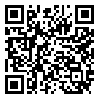Volume 14, Issue 2 (March & April 2023)
BCN 2023, 14(2): 289-296 |
Back to browse issues page
Download citation:
BibTeX | RIS | EndNote | Medlars | ProCite | Reference Manager | RefWorks
Send citation to:



BibTeX | RIS | EndNote | Medlars | ProCite | Reference Manager | RefWorks
Send citation to:
Lohrasbi S, Moradi A R, Sadeghi M. Exploring Emotion Recognition Patterns Among Iranian People Using CANTAB as an Approved Neuro-Psychological Assessment. BCN 2023; 14 (2) :289-296
URL: http://bcn.iums.ac.ir/article-1-2255-en.html
URL: http://bcn.iums.ac.ir/article-1-2255-en.html
1- Institute for Cognitive Science, Shahid Beheshti University, Tehran, Iran.
2- Institute for Cognitive Sciences Studies, Kharazmi University, Tehran, Iran.
2- Institute for Cognitive Sciences Studies, Kharazmi University, Tehran, Iran.
Abstract:
Introduction: Emotion recognition is the main component of social cognition and has various patterns in different cultures and nationalities. The present study aimed to investigate emotion recognition patterns among Iranians using the Cambridge neuro-psychological test automated battery (CANTAB) as a valid neuropsychological test.
Methods: In this descriptive-analytical study, 117 males and females (Mean±SD of age 32.1±6.4) were initially assessed by computerized intelligence and progressive matrices of RAVEN-2. Furthermore, the excitement recognition subtest taken from the Cambridge neuro-psychological test automated battery (CANTAB) was performed. The correct response of participants to each of the six basic emotions as well as the recognition time was used for analysis.
Results: The maximum correct response rate was 75.83% related to happy emotion. The correct responses for sadness, surprise, disgust, anger, and fear were 70%, 68.48%, 47.84%, 42.54%, and 38.26%, respectively. Moreover, the shortest recognition time was related to disgust at 322 ms, while sadness with a mean response time of 1800 ms and fear response time at 1529 ms indicated the longest recognition time. In addition, participants recognized happiness with a mean response time of 1264 ms better than other emotions; however, post-hoc t-test analyses showed that only the correct responses for sadness and surprised emotions did not differ significantly, (t(112)=-0.59, P=0.55, d=0.05). These results suggested that different emotions have various correct responses. However, sadness and surprise did not differ.
Conclusion: The findings of this study could be beneficial for evaluating cognitive elements, as well as cognitive abilities and inabilities among the Iranian population. Moreover, the findings could be used for investigating social cognition in this population.
Methods: In this descriptive-analytical study, 117 males and females (Mean±SD of age 32.1±6.4) were initially assessed by computerized intelligence and progressive matrices of RAVEN-2. Furthermore, the excitement recognition subtest taken from the Cambridge neuro-psychological test automated battery (CANTAB) was performed. The correct response of participants to each of the six basic emotions as well as the recognition time was used for analysis.
Results: The maximum correct response rate was 75.83% related to happy emotion. The correct responses for sadness, surprise, disgust, anger, and fear were 70%, 68.48%, 47.84%, 42.54%, and 38.26%, respectively. Moreover, the shortest recognition time was related to disgust at 322 ms, while sadness with a mean response time of 1800 ms and fear response time at 1529 ms indicated the longest recognition time. In addition, participants recognized happiness with a mean response time of 1264 ms better than other emotions; however, post-hoc t-test analyses showed that only the correct responses for sadness and surprised emotions did not differ significantly, (t(112)=-0.59, P=0.55, d=0.05). These results suggested that different emotions have various correct responses. However, sadness and surprise did not differ.
Conclusion: The findings of this study could be beneficial for evaluating cognitive elements, as well as cognitive abilities and inabilities among the Iranian population. Moreover, the findings could be used for investigating social cognition in this population.
Keywords: Social cognition, Neuropsychological assessment, CANTAB, Emotion recognition, RAVEN-2, Computer-based neuropsychological assessment (CBNA)
Type of Study: Original |
Subject:
Clinical Neuroscience
Received: 2021/08/15 | Accepted: 2021/11/7 | Published: 2023/03/1
Received: 2021/08/15 | Accepted: 2021/11/7 | Published: 2023/03/1
Send email to the article author
| Rights and permissions | |
 |
This work is licensed under a Creative Commons Attribution-NonCommercial 4.0 International License. |








